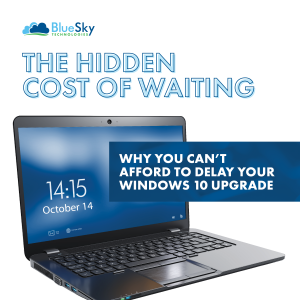 Windows 10 is going away. Here’s why it matters:
Windows 10 is going away. Here’s why it matters:
If you’re still running Windows 10 on your business machines, let’s cut to the chase: The clock is ticking. On October 14, 2025, Microsoft is officially ending support for Windows 10. That means no more security patches, no more bug fixes, and no more technical support.
But here’s what business owners really need to understand: The cost of waiting isn’t just about someday needing to upgrade. It’s about what waiting could cost you in the meantime.
We get it—upgrading every machine in your business isn’t exactly your idea of a fun budget item. It feels easy to delay…until something breaks.
Here’s what procrastination could cost you:
1. You’re Operating Without a Safety Net
Once support ends, Microsoft will discontinue Windows 10 updates. This means every new vulnerability becomes your responsibility and your systems will be left exposed.
Hackers love outdated systems because they’re easy targets. It’s like locking the front door but leaving every window wide open.
One breach could lead to costly damage like data loss, downtime, your reputation—or worse, your entire business.
2. Software & Hardware Compatibility Issues
Many software providers have already begun phasing out support for Windows 10. This includes many business apps, such as accounting tools, CRMs, industry-specific platforms, and other critical business applications.
And it’s not just about software. New printers, peripherals, and even security tools may stop working with your outdated operating system.
What if your systems stop working mid-project or crash during a client demo? When your tools break, productivity takes a direct hit.
3. Lost Productivity
Even without a crash, older operating systems tend to slow down over time. They lag, they freeze, and they frustrate your team, dragging down efficiency, morale, and your ability to compete.
If each employee loses 10 to 15 minutes a day to tech slowdowns, how much time—and money—are you losing each month?
4. Emergency Upgrades Always Cost More
Waiting for your systems to fail doesn’t just create stress, it creates “panic spend” mode:
- Emergency Hardware orders
- Rush IT Labor Fees
- Business Interruptions
A little planning now saves you from stress—and costly surprises—later.
5. You’re Risking Compliance Violations
If your business handles sensitive data or is subject to regulations like HIPAA or PCI-DSS, using unsupported systems could result in fines or lawsuits.
Many regulatory frameworks require up-to-date security, and Windows 10 won’t meet those standards come October.
What Smart Business Owners Are Doing Now:
They’re using this deadline as an opportunity—not just to update devices, but to improve their overall IT strategy. That includes:
- Auditing Systems & Retiring Outdated Hardware
- Streamlining Tools & Software
- Strengthening Cybersecurity Defenses
- Planning Smarter for IT Spend in 2025
How To Make the Transition Smooth:
Here’s what we recommend:
- Run a Compatibility Check. Not all machines can run Windows 11. Find out which ones need to be replaced.
- Audit Your Apps. Make sure your essential tools are ready to run on Windows 11 or newer environments.
- Budget For Hardware Now. Don’t get stuck in a supply chain crunch later.
- Partner With an IT Provider. We can handle the transition from start to finish, ensuring minimal downtime and no surprises.
Don’t Wait Until October
The sooner you prepare, the smoother the transition will be. Waiting until the last minute will cost you more—in money, stress, and time. We’re helping small businesses make the upgrade the smart way: planned, smooth, and optimized for future growth.
Use the form on this page to book a FREE consultation and we’ll help you identify what needs upgrading, what can stay, and how to build a transition plan that won’t disrupt your business before the deadline.


